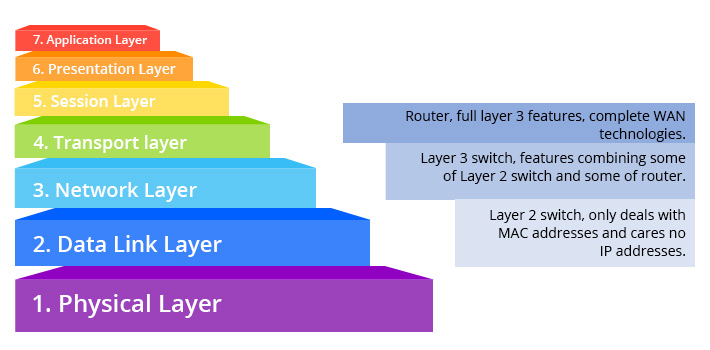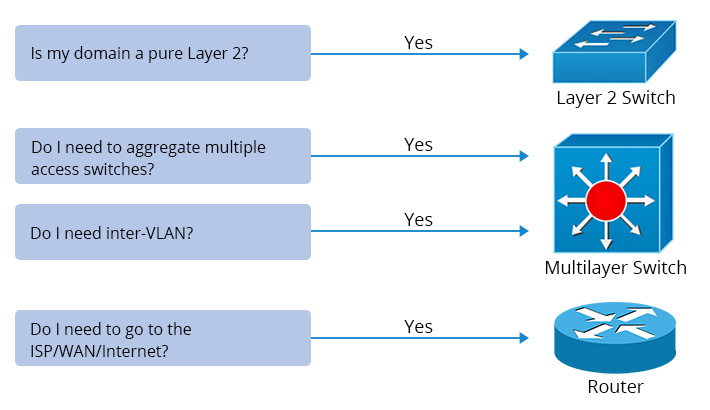In general, a Layer 2 switch is one of the fundamental devices used to connect all networks and client devices. However, with the increasing diversification of network applications and the realization of network convergence, Layer 3 switches have flourished in data centers, complex enterprise networks, and commercial applications. So, the question arises: Between Layer 2 switches and Layer 3 switches, which one is the right choice for network switching?
The Open Systems Interconnection (OSI) model employs Layer 2 switches and Layer 3 switches. This model is a reference framework for describing and explaining network communication. The OSI model consists of seven layers: Application, Presentation, Session, Transport, Network, Data Link, and Physical. Layers 2 and 3 correspond to the Data Link and Network layers, respectively. Switches that operate in these layers are known as Layer 2 switches and Layer 3 switches.

Figure 1: Layers 2 and 3 in the OSI model.
The primary distinction between Layer 2 and Layer 3 lies in their routing capabilities. Layer 2 switches only use MAC addresses and do not concern themselves with IP addresses or higher-layer details. Layer 3 switches, or multi-layer switches, can perform all the functions of Layer 2 switches, along with added static and dynamic routing. This means that Layer 3 switches have both MAC address tables and IP routing tables, enabling them to handle VLAN communication and packet routing between different VLANs. There are also Layer 2+ (Layer 3 Lite) switches that only add static routing. Beyond packet routing, Layer 3 switches include features that require knowledge of entering data's IP addresses, such as tagging VLAN traffic based on IP addresses rather than manual port configuration. Layer 3 switches enhance power and security as needed.
When deciding between Layer 2 and Layer 3 switches, consider the application context. If you have a pure Layer 2 domain, a Layer 2 switch is sufficient. A pure Layer 2 domain is where hosts are connected, and Layer 2 switches function there. This is often referred to as the access layer in network topology. If you need to aggregate switches and perform VLAN routing between them, a Layer 3 switch is necessary. This corresponds to the distribution layer in network topology.

Figure 2: When to use Layer 2 switches, Layer 3 switches, and routers?
When purchasing either Layer 2 or Layer 3 switches, several key parameters should be examined, including forwarding rate, backplane bandwidth, VLAN count, MAC address memory, and latency.
Forwarding rate (or throughput) refers to the capacity of the backplane (or switching fabric) to forward data. When the forwarding capacity surpasses the sum of all port speeds, it's considered non-blocking. The forwarding rate is measured in packets per second (pps). The calculation formula for switch forwarding rate is as follows:
Forwarding rate (pps) = 10Gbit/s port count * 14,880,950 pps + 1 Gbit/s port count * 1,488,095 pps + 100Mbit/s port count * 148,809 pps
For instance, if the FS S5850-32S2Q has 32 10G ports and 2 40G ports, its forwarding rate is:
32 * 14,880,950 pps + 2 * 4 * 14,880,950 pps = 595,238,000 pps ≈ 596 Mpps
The next parameter is backplane bandwidth or switching fabric capacity, which is the sum of all port speeds. The sum of all port speeds is calculated twice, once for Tx direction and once for Rx direction. Backplane bandwidth is expressed in bits per second (bps).
Backplane bandwidth (bps) = Port count * Port data rate * 2
Thus, for the S5850-32S2Q, the backplane bandwidth is:
(32 * 10 Gbps + 2 * 40 Gbps) * 2 = 800 Gbps
Another crucial parameter is the configurable VLAN count. Generally, a Layer 2 switch with 1K (1024) VLANs is sufficient, while a typical VLAN count for Layer 3 switches is 4k (4096). The MAC address table memory indicates the number of MAC addresses the switch can store, typically represented as 8k or 128k. Latency refers to the delay time experienced during data transmission, and it's desirable to be as short as possible, usually measured in nanoseconds (ns).
Our switches, backed by Quality Assurance, deliver seamless connectivity and advanced features. Choose C-Data for reliable, high-quality switches that optimize your network infrastructure. Elevate your network experience with Layer 2 and Layer 3 switches from C-Data.